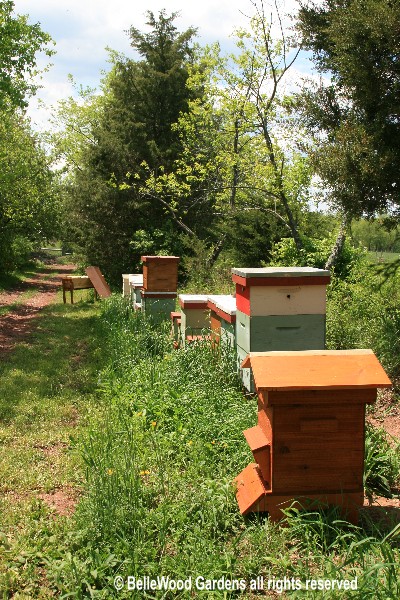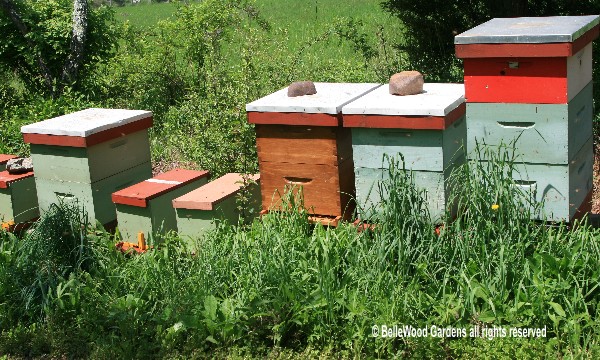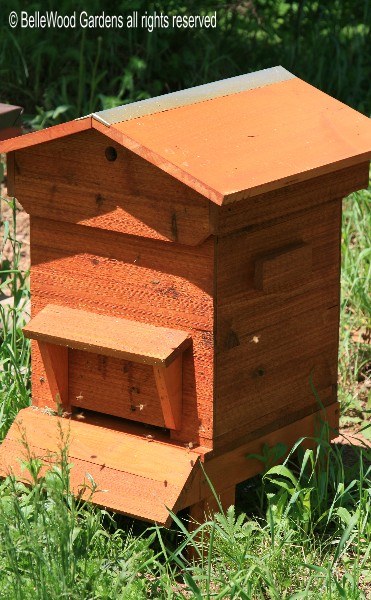
Sunday, 8 May 2011
Swarming Bees
There are bees native to North America, but not honey bees. They are naturalized immigrants that arrived on our shores with English settlers. The first beehives came here back in 1622 on the Discovery (60 tons, Thomas Jones, captain, and twenty persons, along with seeds, fruit trees, pigeons, rabbits, and mastiffs.) Unlike sheep, cattle, or horses, it's difficult if not impossible to corral bees. So honey bees soon began to spread out on their own. They'd swarm, and take up new quarters elsewhere.

Early beehives were called skeps. Made of coiled rye straw, and open on the bottom, bees would fill the interior with combs and honey. It was common to kill the bees in order to safely extract the honey. Skeps, such as the one above which I photographed in Holland back in 1990 are now illegal, because it is not possible to inspect the hive for disease or pests. Improved design also makes honey collection easier.

Jean-Claude Tassot's apiaries are set up on various farms. But of course he has some set up at Buzzing Acres, the farm he and Beatrice have in Milford, New Jersey. These hives have a wooden box with frames inside. Each frame is an inch wide, and frames are spaced 3/8 inch apart. Any wider, and the bees would fill the space with honeycomb, any less and the passageway would be too small for the bees to move around in the hive. Most look like simple boxes, each called a super. Once filled with honey, another super can be added so the bees can store more honey.

.

This is a Belgian style hive, Jean-Claude said. Like the others it is,
I think, a variation on the Langstroth hive, invented in England by
the Reverend Lorenzo Langstroth in 1860. Still popular 150 years
later, this type of hive with its adjustable, interchangeable frames
is still used by about seventy-five percent of all bee keepers.
Jean-Claude and I were having an interesting conversation. I asked about the English custom I'd heard of, that bees must be told of births and deaths in the bee-keepers family. He shrugged, and said that there was a French version, that bees would follow the bee-keepers coffin to the cemetery. That had some basis, because when paint was expensive the wood for beehives would be protected from rain and rot by rubbing it with beeswax. Coffins too, would be finished with beeswax, and so the bees were following a familiar scent.
Suddenly he stopped, peering at the tree at the end of the alley's apiary row. "They've swarmed." he announced. "I have to get my bee suit." It is important for beekeepers to carefully monitor their hives in late Spring. At a time when the other areas of the hive are rapidly filling with honey, they keep watch for the appearance of queen cells. This is a dramatic signal that the colony is determined to swarm. Jean-Claude had anticipated swarming and even sprayed synthetic pheromone as a lure on the uninhabited double hive left open beneath the tree.

Clad in his bee suit, hooded, and with a pail on a long extensible pole
Jean-Claude must try and gently joggle the swarm and queen into
the bucket and pour the several gallons of disturbed bees into the hive.

.

Hands in pockets (he wasn't wearing gloves and yes, he did get stung 5 or 6 times) Jean-Claude peers
into the hive. If the bees settle, he'll know the queen is there. If they lift off again, she's not. It took
two more attempts but in the end - success. The mature queen and numerous young energetic
worker bees were successfully relocated to a nice hive rather than buzzing off in search of a hollow tree.